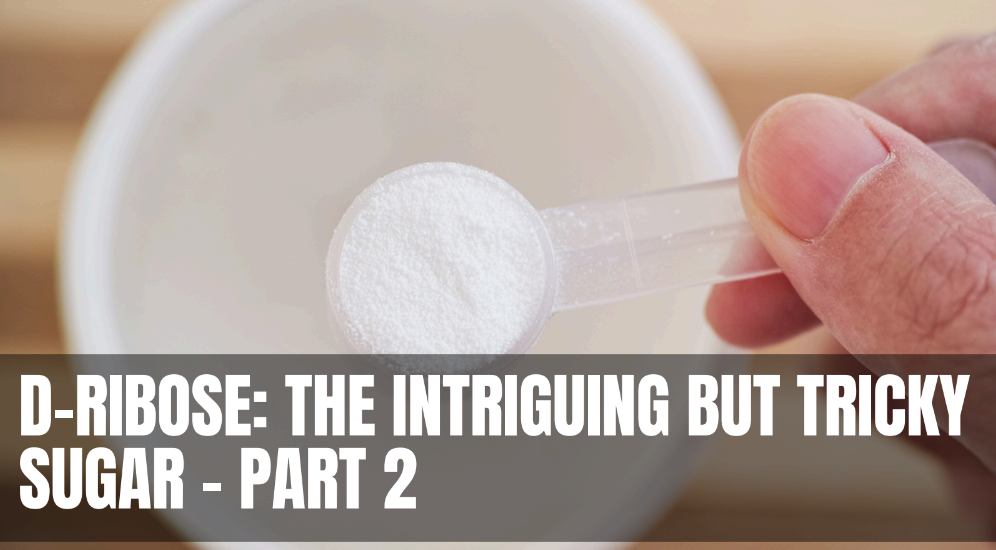D-Ribose: The intriguing but Tricky Sugar – Part 2

Friends:
I am starting section 2 with the ending of the first section:
“Herein lies the question in human applications of what is too much, too long, and where are the endpoints? What are the possible consequences and cautions of exceeding the endpoints of chronic dosing? “
Below is a progression of some of the many features that display good effects with smaller or optimal amounts or for a limited time of use, to the harmful effects of excess–again, this is all relative and a function of one’s biochemical individuality, and again, the expression, timing, and order of one factor listed below is merely a guide and is not necessarily contingent upon the preceding factors.
GENERAL CONCEPT OF D-RIBOSE PROGRESSION FROM GOOD TO HARMFUL ( TOP TO BOTTOM)
WHEN SAFE AND BALANCED AMOUNTS ARE USED THE BODY CAN HANDLE AND METABOLIZE
Cardiac synergist
Promoting Anti-Fatique and synthesis of ATP
Improves Cardiac ischemia
Promotes insulin release and lowers blood sugar
Weakens immune suppression caused by viruses
May help relieve muscle pain syndrome

My major concern personally about D-ribose ( and other reducing sugars, including less severely, even the alcohol sugars and even to a slightly lesser extent fructose and glucose ) is their rapid creation of AGE ( Advanced Glycation Endporudcts) and RAGE (the receptor sites for the AGE molecules).
AGEs are the products of nonenzymatic glycation and oxidation of sugars to proteins and lipid oxidants that can create a variety of damaging cellular and metabolic dysfunctions. This chemical reaction with sugars that creates AGE is called a “maillard reaction”. For example, it’s also part of the browning and tasty outcome of frying and BBQ–delicious, but too much may create excessive AGE risks–darn it!
‘NUTRIENTS” 2010 Dec; 2(12): 1247–1265.
Published online 2010 Dec 13.
“Advanced glycation end products (AGEs) are a heterogeneous, complex compound formed mainly via the Maillard reaction. The Maillard reaction occurs when reducing sugar reacts in a non-enzymatic way with amino acids in proteins, lipids, or DNA”.
As mentioned but important to emphasize, these dangerous molecules can be formed in the body by our metabolism, especially if we have high blood sugar, as well as sources from the diet and our methods of cooking ( that to be more deeply explained in Dr. Koz’s next article)
RAGE was initially identified as a receptor for advanced glycation end products. RAGE showed that this receptor is most abundantly expressed in skeletal muscle, lung, and heart, creating inflammation and dysfunction.
However, the body can eliminate AGE molecules pretty well if not chronically excessive and prior to more permanently damaged organs and blood vessels.
Exercise also helps to rid us of early-developing AGE molecules.
Diabetics are far more susceptible to creating AGE molecules as well as those who are prediabetic, however, AGE is not limited to diabetics; can happen and accumulate in healthy individuals so don’t become complacent!
Remarkably, diabetics and prediabetics will metabolize and create more polyols and D-ribose from various sugar metabolism pathways than non-diabetics!
However, these body-made molecules are ironically fairly easily subject to glycation, which is the basis for much of the diabetic damage to all tissues.

When molecules are glycated, they become inflammatory and can create metabolic dysfunction in the brain, heart, muscles, and kidneys.
Several compounds may have the ability to help prevent and reverse glycation and its deleterious effects.
Benfotiamine ( a synthesized form of fat-soluble Thiamin–Vitamin B1) and carnosine have demonstrated anti-glycation activity that
may also help slow aging.
From our diet, fruits, veggies, and things like dark chocolate and tea, have powerful antioxidants that help protect cells from glycation.
Specifically, blueberries, pomegranate, and tea are super antioxidants. A regular supply of these in your diet helps save your skin from the effects of AGEs.
However, roasted coffee has lots of “maillard compounds”, that give a rich taste and flavor, but it also has many wonderful and special health benefits– my advice, consume it in moderation, and you should be fine.
So, what do I do personally?
Though I am in excellent physical health, my blood sugar has been stubborn all my life, on the high side, and thus will pay particular attention if I wish to take some D-Ribose.
I am not suggesting this may be your prescription, but when I do take some D-Ribose, usually when anticipating some extra stamina needed for extra exertion and recovery ( intense bike ride, gym, or a tough hike) it is very occasional, about one gram, with plenty of accompanying antioxidants, and sometimes I will also include a small capsule of Benfotiamine.
Even so, with all the prep, I still have some of the AGE “monkey on my back,” wondering if I covered all the bases!
More of AGE and RAGE will be my next Dr. Koz column– so stay tuned!
